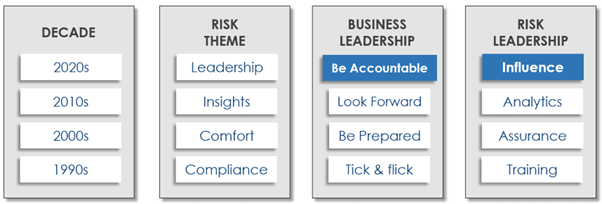Last week I spoke on strategy execution at the Better Boards conference in Brisbane, Australia. As speaker after speaker addressed the audience, it became increasingly clear that boards and their advisers are “getting” strategy and risk are two sides of the same coin. The need for managing risk to help ensure organisational success was a key theme.
How leaders and advisors view and treat risk has significantly changed over the past 35 years, an evolution I’ve outlined in the below Risk Management Through the Decades diagram.

Risk Management Through the Decades
I first revealed this evolution in 2021 at the launch of my book Risky Business: How Successful Organisations Embrace Uncertainty explaining to the 200-plus risk professionals, clients, friends and family from more than 20 countries how I had observed businesses change from treating risk as a compliance activity to valuing it for the insights and leadership it provides: insights and leadership that help decision makers make better, faster decisions within an agreed appetite for risk.
A poll I conducted at the time found that just over 50% said their organisation was operating above the line in the 2010s or 2020s, with just over 20% in the 2020s. Sadly, almost 50% were not treating risk as a valuable insight, with 14% in the 1990s.
Since the launch of Risky Business, I’ve found more and more businesses have grasped the 2020s version of viewing and managing risk. I’ve helped some organisations personally, while I have heard others make comments like “If you don’t understand your risks, how can you nail a good strategy?”
The presentations and the discussions at the Better Boards conference were further evidence for me that business leaders have moved from treating risk as a tick and flick add-on to a position where they hold themselves accountable for managing the uncertainty surrounding the achievement of their organisational goals. Thank goodness!
I’d enjoy hearing whether your organisation has embraced this way of viewing and managing risk. Let me know what you think in the comments.

